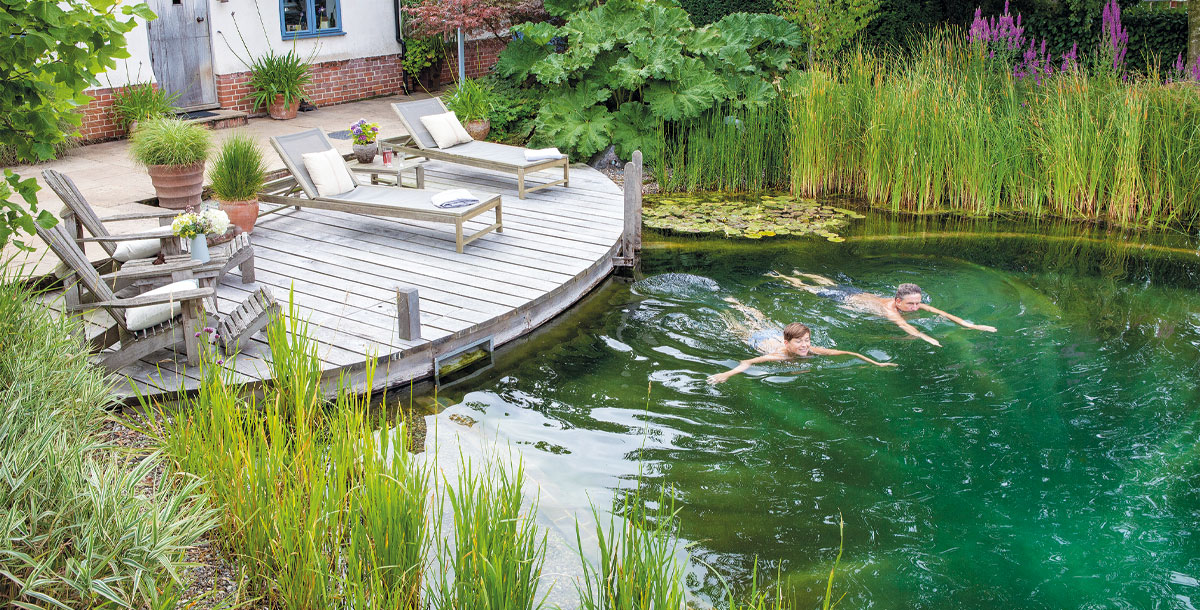Swimming ponds: a buyer’s guide
When set up correctly, this natural ecosystem keeps the water crystal clear
Swimming ponds or pools rely on biological filtration, rather than chemicals, to keep the water clean enough for you to bathe in. You can do anything in them that you would do in a conventional pool, including diving in.
Many incorporate jetties for this purpose, and a deep end up to 2.4m. It’s also possible to specify waterfalls and fountains as part of the design.
But there are some things to avoid – such as fish. ‘Fish eat many of the aquatic animals and plants that play an important role in keeping the water clear,’ says Paul Mercer of The Swimming Pond Company.
They also stir up the sediment, which is unpleasant to swim in and puts pressure on the filtration system.
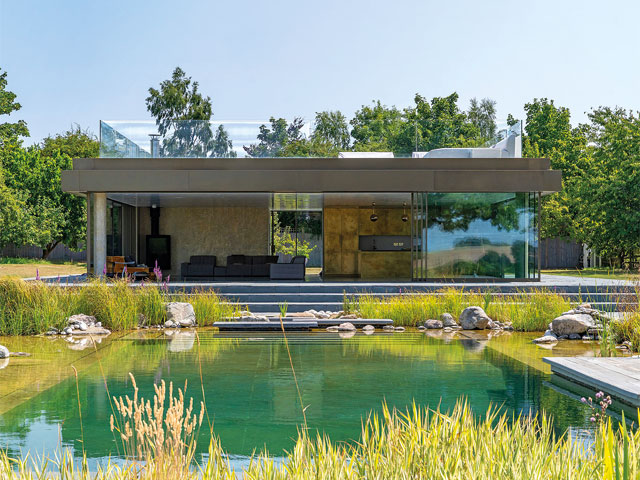
Measuring 242sqm, this natural swimming pool in Kent includes a pool house that contains a kitchen, office, shower and WC, with a green slate terrace and steps. Pool from Gartenart. Photo: Gartenart
Pond or pool?
The term swimming pond usually refers to a natural- looking design with a planted filtration bed and surrounding vegetation, whereas a swimming pool looks more formal and has fewer plants.
It may even eschew greenery altogether and use a sand-based filtering system like the ‘living’ pools by Austrian company Biotop, which has UK partners including Ellicar.
Natural filtration
A swimming pond is divided into two zones. There’s a bathing area and a section filled with plants that clean the water naturally, which is known as the regeneration zone. Whereas a living pool with a sand-based filter system doesn’t have to be divided.
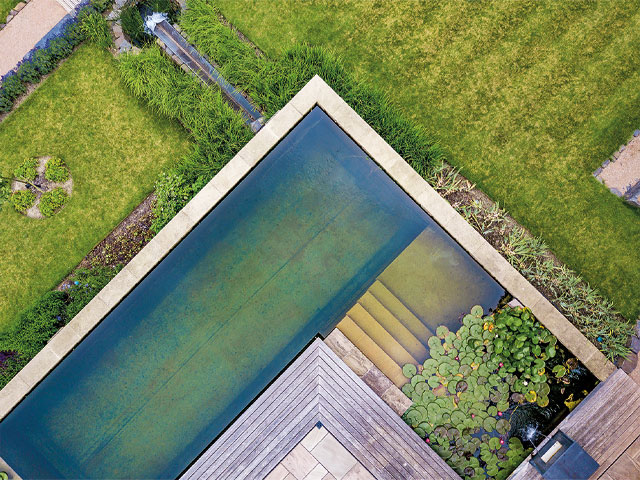
Built on a hillside in Wales, this natural 122sqm pool by Ellicar sits at the top of a sloping walled garden and has a 65sqm swim zone. Underwater steps lead off the larch sun deck. Photo: Ellicar
Is my garden suitable?
A swimming pond requires an open flat area that’s not overhung by trees and the regeneration zone must be at least the same size as the swimming area.
So, to have 50sqm of water to swim in, which is a typical size, the pond will measure around 100sqm. As living pools don’t have a regeneration zone, they are a better option for smaller gardens, measuring from 15-20sqm.
If a garden is not flat, it will require landscaping work, which adds to the total cost of the project.
‘You have to create a level area on sloping ground,’ says Kate Miller of Natural Swimming Pools. ‘But in the process, you could make a beautiful water feature to complement the pond.’
‘You’ll only need to apply for planning permission if your home is listed, in an Area of Outstanding Natural Beauty (AONB) or a conservation area,’ she adds.
Generally, there are no Building Regulations requirements, but any electrical work must meet the National Inspection Council for Electrical Installation Contracting (NICEIC) specifications.
Swim in comfort
It’s not usual to heat either a pond or a pool because it encourages the growth of water-borne nutrients, leading to algae formation.
But as the regeneration zone is relatively shallow, the water warms quickly on a sunny day and is gently pumped into the swimming area raising the temperature – owners report water reaching up to 28ºC in summer.
Most swimming pond companies recommend using a dark green liner as the colour helps the water absorb and retain the sun’s warmth. Plus, pond covers prevent heat loss in winter – but using them may be detrimental to wildlife and plants.
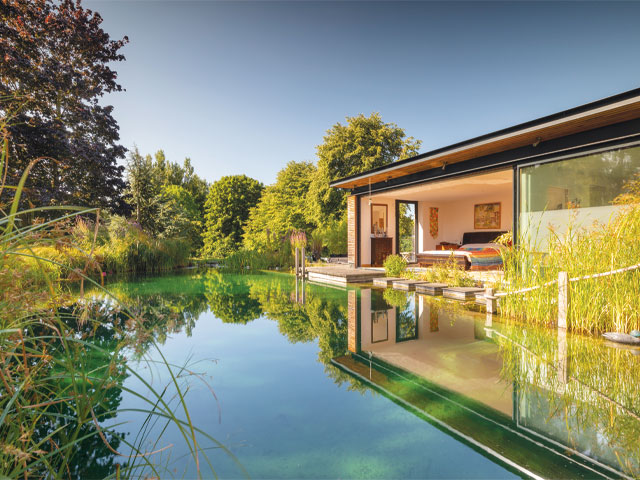
Designed and built by The Swimming Pond Company, this 180sqm pond in Bury St Edmunds, Suffolk, goes up to the house’s glazed bedroom doors. Photo: The Swimming Pond Co.
In at the deep end
The approximate price range for a swimming pond from specialist company Ellicar starts at £96,000 for a 100sqm excavation, £168,000 for 200sqm and £228,000 for 300sqm, not including any decking or paving.
The final costs are subject to the design, finish, ground conditions, access and location specifics. ‘It’s very important to compare construction specifications,’ says Sarah Murch of Ellicar.
‘Ellicar builds to a structural engineer’s reinforced concrete specification and based on a 2m-deep swim zone. The costs will vary if the pond is shallower.’
The cost per sqm decreases as the area increases, so a 160sqm swimming pond can be considerably less than double the cost of an 80sqm one.
‘The price per sqm saving is because of the initial outlay on design and planning, plus getting machinery, waste disposal and deliveries on site,’ says Paul Mercer.
Maintenance issues
Annual running costs are low, especially if you do the necessary work. ‘The most significant task is in mid- November,’ Paul Mercer explains. ‘It involves cutting back and removing any aquatic plants, leaving their root systems intact, so the vegetation doesn’t rot down into the pond during the winter.’
Doing so keeps the water as clean as possible, ensuring nutrient levels remain low and preventing algae bloom come springtime.
Cutting back takes no more than a day for an established pond. Skimming the surface regularly to remove leaves, blossom and seed heads is also recommended. ‘When everything is set up correctly nature should do much of the work for you,’ says Paul.
Hiring a reputable design-and-build company provides reassurance of quality and durability. ‘Gartenart has been building swimming ponds for 20 years, so we know our filtration system lasts at least that long without needing to be replaced,’ says Tim Evans of Gartenart.
‘Some things will need replacing, particularly the pump after five to ten years, and any timber supports such as for decking or a jetty may need replacing after ten years. Plants may also need refreshing every five to ten years.’
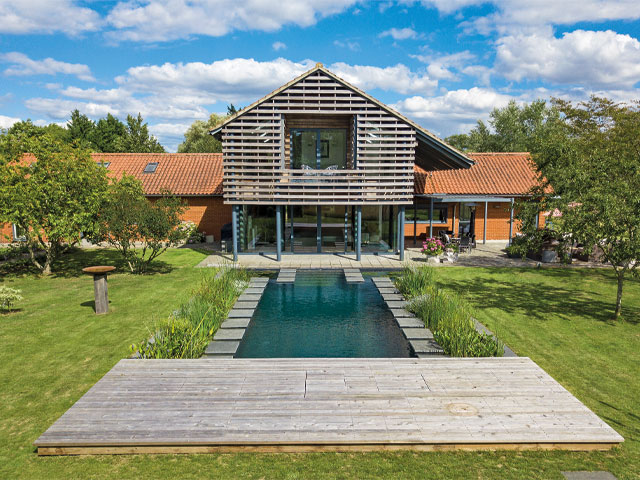
This 75sqm natural swimming pool in Norfolk uses plants for filtration. The owners wanted to encourage wildlife into their garden, but also have space to swim. Photo: Natural Swimming Pools
Proceed with caution
If children or older adults will be around the water, it’s vital to consider their safety. Swimming ponds are often designed with a shallow end, not just for smaller swimmers, but to help wildlife get in and out of the water. A barrier around the edge may not be an ideal solution in a natural setting.
Seven years ago, Nicola and Andrew Hunter, who are in their sixties, asked Paul Mercer to design a swimming pond for their new eco-friendly home in Bury St Edmunds, Suffolk, and were concerned about the safety of their two grandchildren, Gracie, five, and Milo, three.
Andrew came up with an ingenious solution: planters with locking wheels that roll into place, creating a barrier along the water’s edge. Gracie and Milo also wear pool alarm wristbands, which are available for pets too.
The build process
Construction starts by excavating a hole and covering it with a protective liner or membrane. Depending on the soil condition, a concrete or blockwork structure might be required to give the bottom and sides stability.
The pond is divided into two sections of roughly equal size — the swimming area and the regeneration zone.
The latter is filled with gravel and plants such as reeds and water lilies, which absorb the nutrients that cause algae. Planting happens at the end of the process, in May if possible, to maximise settling in and growth time.
‘Your plant selection is crucial for several reasons, including choosing those that thrive in low nutrient conditions and mainly native species offering the greatest benefit to wildlife,’ says Paul Mercer. ‘Avoid invasive plants such as the common bulrush, which is good at absorbing nutrients but wipes out other plants. And the Norfolk reed has a destructive root system known to penetrate liners.’
The two zones are separated by a wall with, typically, a 20-30cm gap to allow water to flow in and out. A mechanical pump circulates clean, filtered water from the regeneration zone into the swimming area.
The build process takes around eight or nine weeks. ‘It’s not a DIY job,’ says Paul Mercer. ‘You need a reputable, established specialist company. Do your research, read customer reviews and visit show swimming ponds to see how they look and work.’
A reputable company will issue its own guarantee lasting at least two years.
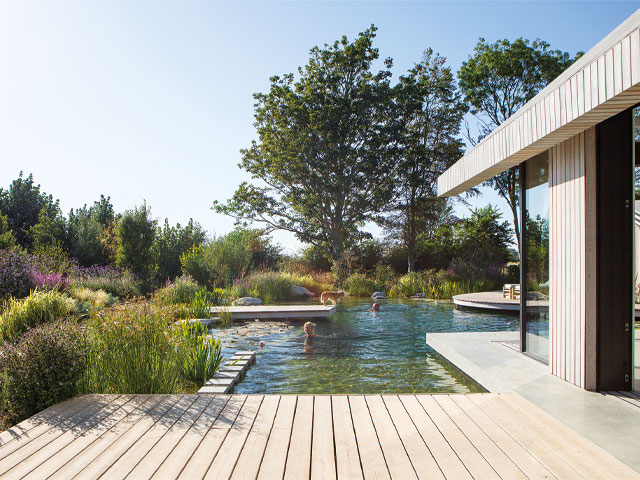
Dan and Nina Rowland rejuvenated the stagnant pond around their self-build home in Bosham, West Sussex. Photo: James French
Welcoming wildlife
Share your watery haven, says Tim Evans of Gartenart.
- Swimming pond water is very similar to the low-nutrient water in a mountain lake. It will last forever if the nutrient level stays low and doesn’t need to be replaced. With regular maintenance it will always be clean and clear.
- The pond changes with the seasons. It’s fantastic for cold-water swimming in winter; is a sociable space in summer; and wildlife such as newts, water boatmen, pond skaters, dragonflies and plants appear from spring onwards.
- If deer, rabbits, badgers and foxes are in your area, they will visit when people aren’t around and particularly at night. The seasons don’t make too much difference to their visiting habits, although they will come for a drink in the hotter, drier periods.
- The only wildlife to discourage are ducks because their waste is high in nutrients.

